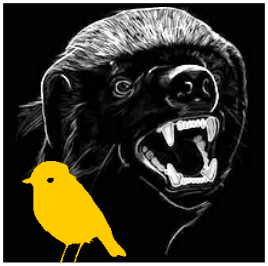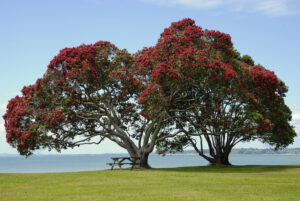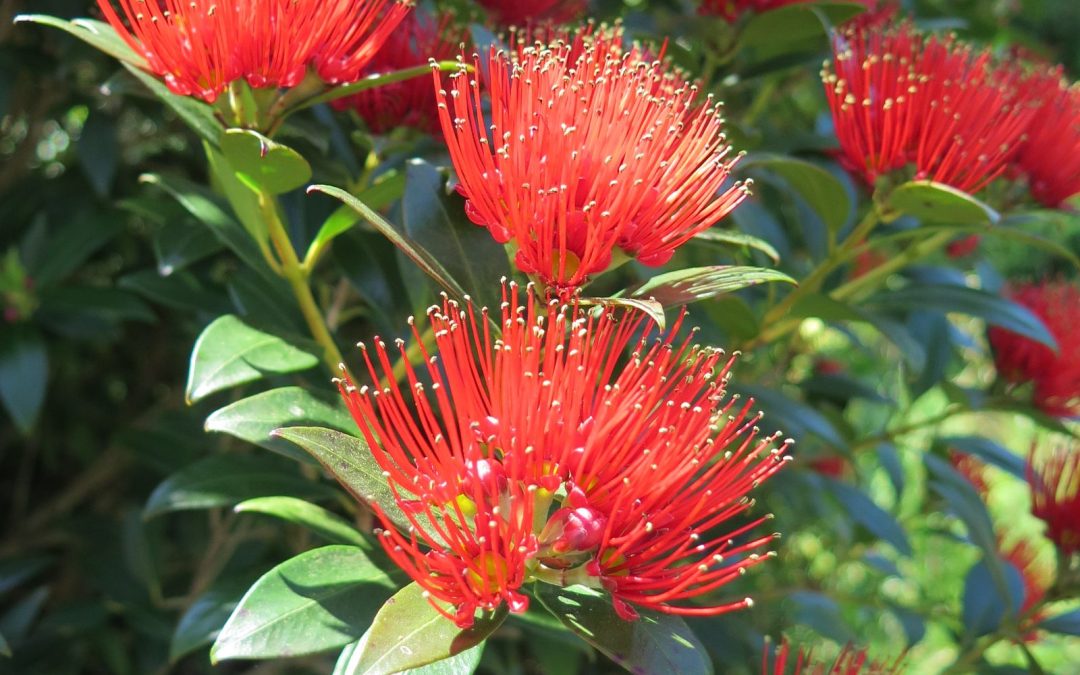Metrosideros angustifolia © Julian Sutton.
Native biotas are today overwhelmed by a series of invasions by plant and animal species introduced artificially from foreign lands and waters, for example Lance-leaf myrtle (Metrosideros angustifolia, above). However, perhaps such catastrophes have always been a temporary part of the natural process of addition to local biotas.
 Prof. Mumblebard claims: “Invasions of non-indigenous plant species are accidents caused directly or indirectly by humans. Because native species are the casualties, it is up to humans to prevent the alien dominance by exterminating the invasive or at least controlling it.”
Prof. Mumblebard claims: “Invasions of non-indigenous plant species are accidents caused directly or indirectly by humans. Because native species are the casualties, it is up to humans to prevent the alien dominance by exterminating the invasive or at least controlling it.”
 Robin and the Honey Badger respond: “Invasive species are ultimately assimilated from alien to indigenous. Although seldom directly observed by scientists, it may be natural for species extending their habitat to do so by means of an unsustainable abundance at the temporary expense – sometimes resulting in extermination – of previous natives. After this, the alien may assimilate as just one more effectively indigenous member of the biota. This can be inferred for lance-leaf myrtle – an example of a natural addition to the South African flora that could not have been imported by humans. Lance-leaf myrtle is the only South African member of a genus otherwise restricted to Pacific Islands and capable of long-distance dispersal by flotation. This non-descript shrub does not dominate vegetation today, instead behaving as a fully assimilated indigenous species despite the fact that an undesirable relative, pohutukawa, has been artificially introduced and is currently invading other parts of South Africa. Lance-leaf myrtle is also quite different in form from all of its congeners, suggesting that its colonising ancestor evolved rapidly as part of its integration in South Africa. A similar process has taken place in the Pacific, where the genus Metrosideros is remarkably plastic genetically and adopts a wide variety of life forms on islands where it has presumably arrived relatively recently by flotation. All of this suggests that rather than simply invading in its present form with permanent catastrophic effects, the ancestor of lance-leaf myrtle adjusted to its new environment with ultimately benign effect.”
Robin and the Honey Badger respond: “Invasive species are ultimately assimilated from alien to indigenous. Although seldom directly observed by scientists, it may be natural for species extending their habitat to do so by means of an unsustainable abundance at the temporary expense – sometimes resulting in extermination – of previous natives. After this, the alien may assimilate as just one more effectively indigenous member of the biota. This can be inferred for lance-leaf myrtle – an example of a natural addition to the South African flora that could not have been imported by humans. Lance-leaf myrtle is the only South African member of a genus otherwise restricted to Pacific Islands and capable of long-distance dispersal by flotation. This non-descript shrub does not dominate vegetation today, instead behaving as a fully assimilated indigenous species despite the fact that an undesirable relative, pohutukawa, has been artificially introduced and is currently invading other parts of South Africa. Lance-leaf myrtle is also quite different in form from all of its congeners, suggesting that its colonising ancestor evolved rapidly as part of its integration in South Africa. A similar process has taken place in the Pacific, where the genus Metrosideros is remarkably plastic genetically and adopts a wide variety of life forms on islands where it has presumably arrived relatively recently by flotation. All of this suggests that rather than simply invading in its present form with permanent catastrophic effects, the ancestor of lance-leaf myrtle adjusted to its new environment with ultimately benign effect.”
Please join us here at the Bio-edge with your own comments. In the discussion below we encourage links to any evidence supporting either Prof. Mumblebard or Robin and the Honey Badger.

Figure 1. Pohutukawa (Metrosideros excelsa, Wikipedia commons).

